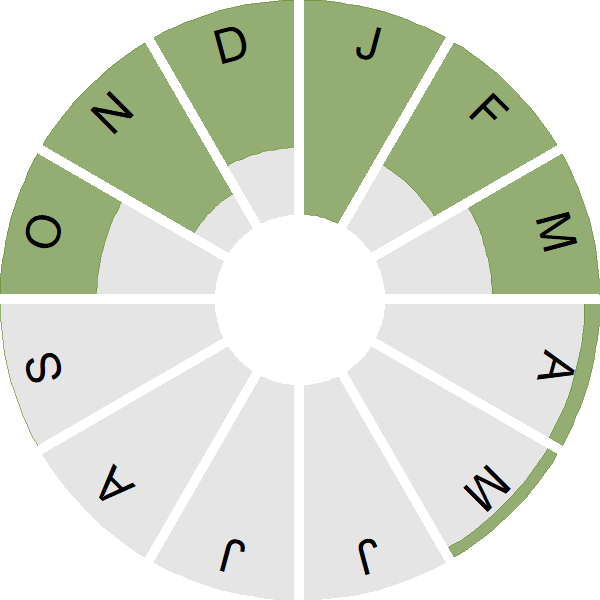Shore Lark

Introduction
As its name suggests, the Shore Lark is found around our shoreline, where it quietly feeds on the seeds of saltmarsh plants washed up along the tidelines.
The Shore Lark is a scarce winter visitor to the UK, occurring mainly on the eastern coasts of England and Scotland. During cold, windswept days this habitat may not be so different from this species' high-Arctic breeding grounds. Shore Larks have distinctive yellow and black facial markings, but their plumage is otherwise mottled brown with a paler underside. Small flocks can be hard to pick out in coastal habitats.
The European breeding population is estimated to be around 7 million pairs. This gives some perspective on its scarcity in the UK, where around 100 birds can arrive in a winter. Like most birds escaping the freezing conditions further north, Shore Lark numbers fluctuate wildly between years, depending on the severity of the weather the birds are escaping.

Key Stats
Identification
Songs and Calls
Song:
Flight call:
Status and Trends
Conservation Status
Population Size
Population Change
Shore Lark is predominantly a scarce winter visitor to the UK; approximately 100 individuals winter here [Woodward et al. 2020], mostly on the east coast of England and southeast Scotland [Balmer et al. 2013]. There have been various records of individuals in suitable breeding habitat in the breeding season but only two confirmed breeding records in the UK, from 1977 and 2003, both in Scotland [Eaton et al. 2022]. No population trend is available for this species in the UK but the European population is thought to be stable [BirdLife International 2019].
Distribution
Shorelarks are mostly recorded mostly in winter, predominantly in coastal habitats on the east coast of England and in southeast Scotland, where they feed on the tideline and amongst saltmarsh and sand-dune vegetation. Shorelarks have been confirmed to breed in the UK in only two years, most recently in 2003. None were recorded in suitable breeding habitat during 2008–11.
Occupied 10-km squares in UK
or view it on Bird Atlas Mapstore.
or view it on Bird Atlas Mapstore.
European Distribution Map
Distribution Change
The winter distribution of Shorelarks in Britain has changed little since the 1981–84 Winter Atlas; a 4% range contraction was recorded. Gains and losses tend to balance out, particularly along the east coast.
Change in occupied 10-km squares in the UK
or view it on Bird Atlas Mapstore.
Seasonality
Shore Lark is an autumn and winter visitor, typically arriving in October.
Weekly pattern of occurrence
The graph shows when the species is present in the UK, with taller bars indicating a higher likelihood of encountering the species in appropriate regions and habitats.

Movement
Britain & Ireland movement
Foreign locations of birds ringed or recovered in Britain & Ireland
Dots show the foreign destinations of birds ringed in Britain & Ireland, and the origins of birds ringed overseas that were subsequently recaptured, resighted or found dead in Britain & Ireland. Dot colours indicate the time of year that the species was present at the location.
- Winter (Nov-Feb)
- Spring (Mar-Apr)
- Summer (May-Jul)
- Autumn (Aug-Oct)

Biology
Productivity and Nesting
Nesting timing
Egg measurements
Clutch Size
Survival and Longevity
Survival is shown as the proportion of birds surviving from one year to the next and is derived from bird ringing data. It can also be used to estimate how long birds typically live.
View number ringed each year in the Online Ringing Report.
lifespan
Biometrics
Wing length and body weights are from live birds (source).
Wing length
Body weight
Ring Size
Classification, names and codes
Classification and Codes
- Order: Passeriformes
- Family: Alaudidae
- Scientific name: Eremophila alpestris
- Authority: Linnaeus, 1758
- BTO 2-letter code: SX
- BTO 5-letter code: SHOLA
- Euring code number: 9780
Alternate species names
- Catalan: alosa banyuda
- Czech: skrivan ouškatý
- Danish: Bjerglærke
- Dutch: Strandleeuwerik
- Estonian: sarviklõoke
- Finnish: tunturikiuru
- French: Alouette hausse-col
- Gaelic: Uiseag-adharcach
- German: Ohrenlerche
- Hungarian: havasi fülespacsirta
- Icelandic: Fjallalævirki
- Irish: Fuiseog Adharcach
- Italian: Allodola golagialla
- Latvian: ausainais cirulis
- Lithuanian: geltongurklis raguotasis vieversys
- Norwegian: Fjellerke
- Polish: górniczek (zwyczajny)
- Portuguese: calhandra-cornuda
- Slovak: uškárik vrchovský
- Slovenian: uhati škrjanec
- Spanish: Alondra cornuda
- Swedish: berglärka
- Welsh: Ehedydd Traeth

